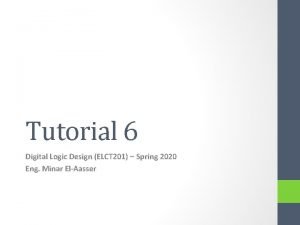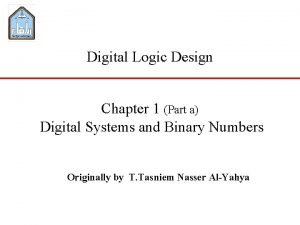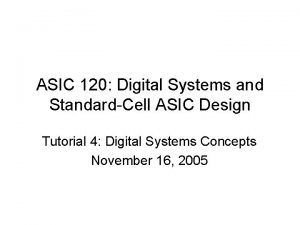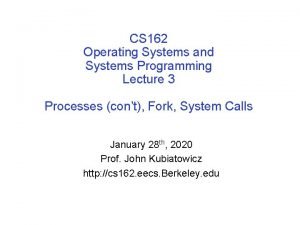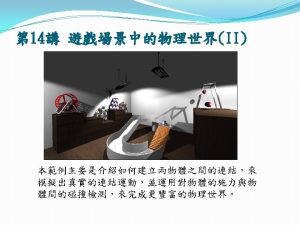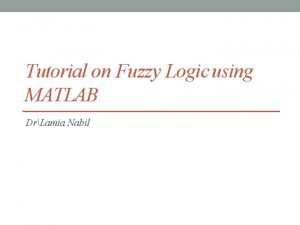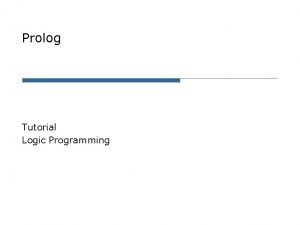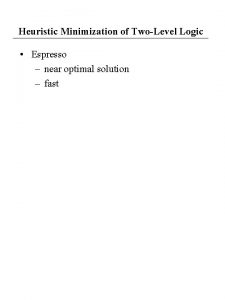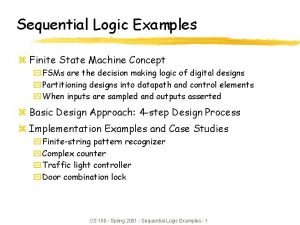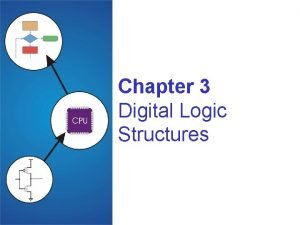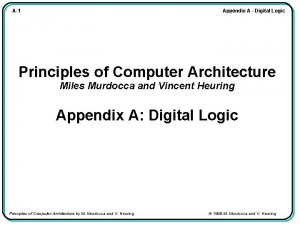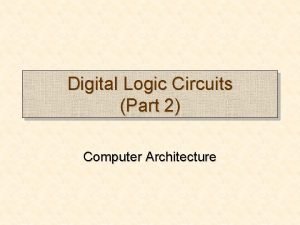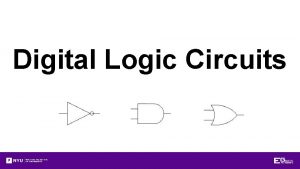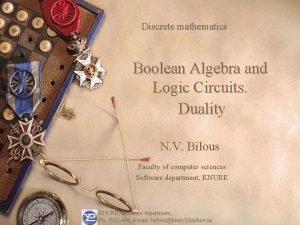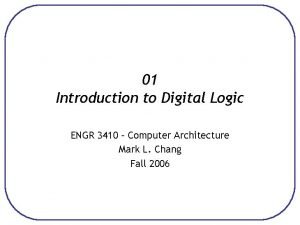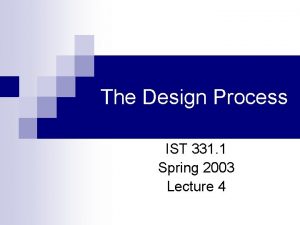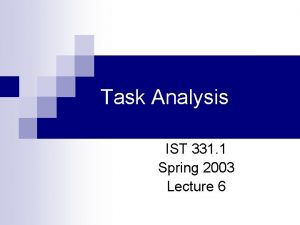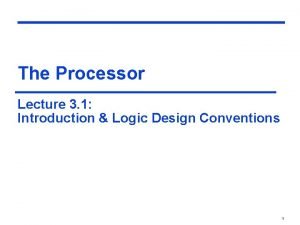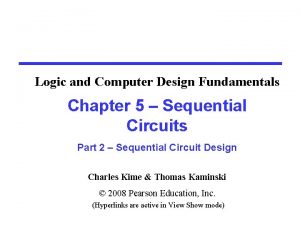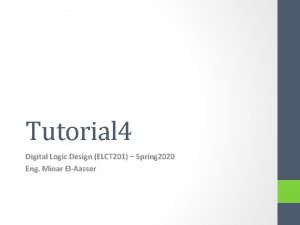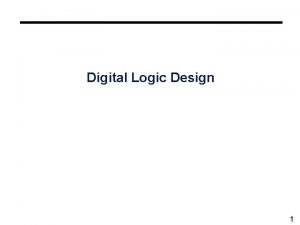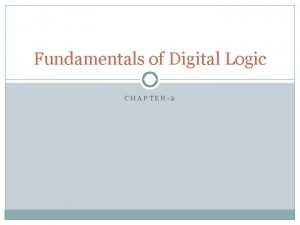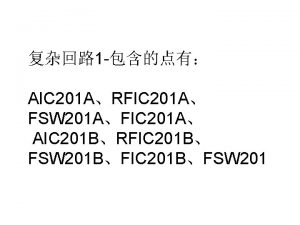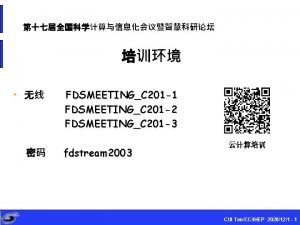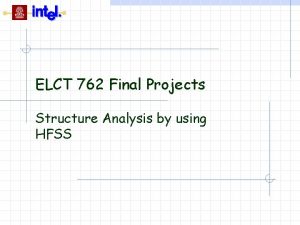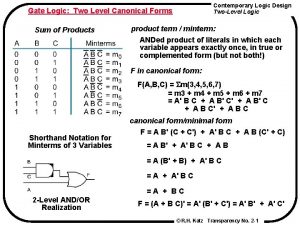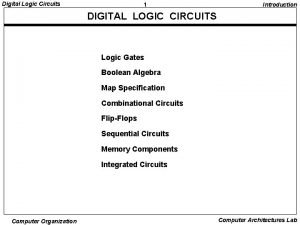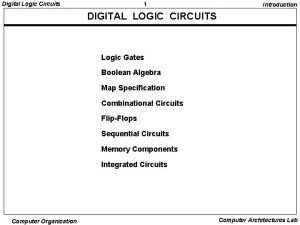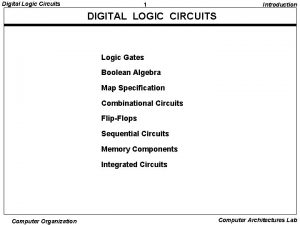Digital Logic Design ELCT 201 Spring 2020 Tutorial















































- Slides: 47

Digital Logic Design ELCT 201 Spring 2020 Tutorial 10 Design of Finite State Machines (FSMs) Eng. Heba Elhosary 1

Mealy Vs. Moore FSM Present State = Flip-Flop output • Mealy FSM Output of the FSM depends on the inputs along with the present state (Flip-flop outputs) • Moore FSM Output depends on the present state only 2

Problem 1: Problem I: Using T flip-flops, design a sequential circuit that implements the following recurring sequence: 000 → 010 → 001 → 101 → 000 →. . . STEP 1: Sketch state Diagram. Eng. Heba Elhosary 3

STEP 2: Tabulate State Table Present State Next State Flip-Flop inputs 0 0 1 0 0 0 1 0 1 1 0 0 1 1 1 0 0 0 1 0 1 0 0 0 1 1 1 0 0 1 1 1 0 0 0 1 1 1 T Q(t+1) 0 Hold 1 Toggle Eng. Heba Elhosary 4

STEP 2: Tabulate State Table Present State Next State Flip-Flop inputs 0 0 1 0 0 0 1 0 1 1 0 0 1 1 1 0 0 0 1 0 1 0 0 0 1 1 1 0 0 1 1 1 0 0 0 1 1 1 T Q(t+1) 0 Hold 1 Toggle Eng. Heba Elhosary 5

STEP 2: Tabulate State Table Present State Next State Flip-Flop inputs 0 0 1 0 0 0 1 0 1 1 0 0 1 1 1 0 0 0 1 0 1 0 0 0 1 1 1 0 0 1 1 1 0 0 0 1 1 1 T Q(t+1) 0 Hold 1 Toggle Eng. Heba Elhosary 6

Step 3: Construct K-maps Eng. Heba Elhosary 7

Step 3: Construct K-maps 1 1 1 Eng. Heba Elhosary 8

Step 3: Construct K-maps Eng. Heba Elhosary 9

Step 3: Construct K-maps 1 1 1 Eng. Heba Elhosary 10

Step 3: Construct K-maps Eng. Heba Elhosary 11

Step 3: Construct K-maps 1 1 Eng. Heba Elhosary 12

Step 4: Draw the logic diagram • Eng. Heba Elhosary 13

Problem 2 Problem II: Using D flip-flops, design a Moore FSM that detects 3 consecutive 0 s in a bit stream. A continuous bit stream is fed at the input of the circuit. Every time the circuit detects the sequence 000, an output line is made HIGH. 1 STEP 1: Sketch state Diagram 0 1 1 0 0 Eng. Heba Elhosary 14

Step 2: Tabulate state table Present State I/P Next State X O/P Flip-Flop inputs Z 0 0 1 0 0 1 0 0 1 1 0 0 0 1 1 1 0 0 0 1 1 1 1 0 0 D Q(t+1) 0 0 1 1 Eng. Heba Elhosary 15

Step 2: Tabulate state table Present State I/P Next State X O/P Flip-Flop inputs Z 0 0 1 0 0 1 0 0 1 1 0 0 0 1 1 1 0 0 0 1 1 1 1 0 0 D Q(t+1) 0 0 1 1 Eng. Heba Elhosary 16

Step 3: Construct K-maps Eng. Heba Elhosary 17

Step 3: Construct K-maps 1 1 1 Eng. Heba Elhosary 18

Step 3: Construct K-maps Eng. Heba Elhosary 19

Step 3: Construct K-maps 1 1 1 Eng. Heba Elhosary 20

Step 3: Construct K-maps Eng. Heba Elhosary 21

Step 3: Construct K-maps 1 1 Eng. Heba Elhosary 22

Problem 2 -b 1/0 • Using D flip-flops, design a Mealy FSM that detects 3 consecutive 0 s in a bit stream. Input Output 0/0 STEP 1: Sketch state Diagram 1/0 0/0 0/1 Eng. Heba Elhosary 23

Step 2: Tabulate state table Present State I/P Next State X O/P Flip-Flop inputs Z 0 0 1 0 0 1 0 0 1 1 0 0 0 1 0 1 0 0 0 1 1 0 x x x 1 1 1 x x x D Q(t+1) 0 0 1 1 Eng. Heba Elhosary 24

STEP 3: Construct K-maps Eng. Heba Elhosary 25

Step 3: Construct K-maps 1 1 x x 1 Eng. Heba Elhosary 26

Step 3: Construct K-maps 1 Eng. Heba Elhosary 27

Step 3: Construct K-maps 1 1 x x 1 Eng. Heba Elhosary 28

Step 3: Construct K-maps 1 Eng. Heba Elhosary 29

Step 3: Construct K-maps 1 x x 1 Eng. Heba Elhosary 30

Step 4: Draw the logic diagram 31

Recall: Excitation Table Q(t) Q(t+1) J K 0 0 0 x 0 1 1 x 1 0 x 1 1 1 x 0 Eng. Heba Elhosary 32

Problem 3: • Problem III: Using JK flip-flops, design a sequential circuit that is able to detect the bit sequence 001. A continuous bit stream is fed at the input of the circuit. Every time the circuit detects the sequence 001, an output line is made HIGH. 1 1 0 STEP 1: Sketch state Diagram 1 0 0 1 0 33

STEP 2 : Tabulate state table Present State I/P Next State X O/P Flip-Flop inputs Z 0 0 1 0 0 X 1 X 0 0 1 0 0 X 0 1 0 0 1 X X 1 0 1 1 0 0 X X 1 1 0 0 X 1 0 1 1 1 0 X 0 1 X 1 1 0 0 1 1 X 0 1 1 1 0 0 1 X 1 Q(t) Q(t+1) J K 0 0 0 X 0 1 1 X 1 0 X 1 1 1 X 0 Eng. Heba Elhosary 34

Step 3: Construct K-maps Eng. Heba Elhosary 35

Step 3: Construct K-maps 1 x x Eng. Heba Elhosary 36

Step 3: Construct K-maps Eng. Heba Elhosary 37

Step 3: Construct K-maps x x 1 1 Eng. Heba Elhosary 38

Step 3: Construct K-maps Eng. Heba Elhosary 39

Step 3: Construct K-maps 1 1 x x Eng. Heba Elhosary 40

Step 3: Construct K-maps Eng. Heba Elhosary 41

Step 3: Construct K-maps x x 1 1 Eng. Heba Elhosary 42

Step 3: Construct K-maps Eng. Heba Elhosary 43

Step 3: Construct K-maps 1 1 Eng. Heba Elhosary 44

Step 4: Draw Logic Diagram • 45

FSMs Design Steps 1. 2. 2. 1 3. 4. Sketch state diagram. Tabulate characteristic/Excitation table for the exploited flip-flop. Tabulate state table Construct k-maps for flip-flop inputs and the outputs(if any) Draw logic diagram Eng. Heba Elhosary 46

E-mail Heba. elhosary@guc. edu. eg 47
 Digital logic design tutorial
Digital logic design tutorial Digital logic design number system
Digital logic design number system Digital logic design practice problems
Digital logic design practice problems Digital logic design lectures
Digital logic design lectures Digital logic design
Digital logic design Giduk
Giduk Is may spring or summer
Is may spring or summer Digital system design tutorial
Digital system design tutorial Spring io conference 2020
Spring io conference 2020 Math enrichment spring 2020
Math enrichment spring 2020 Cs162 spring 2020
Cs162 spring 2020 First order logic vs propositional logic
First order logic vs propositional logic First order logic vs propositional logic
First order logic vs propositional logic First order logic vs propositional logic
First order logic vs propositional logic Combinational logic circuit vs sequential
Combinational logic circuit vs sequential Tw
Tw 캠블리 단점
캠블리 단점 Combinational logic sequential logic
Combinational logic sequential logic Combinational logic sequential logic 차이
Combinational logic sequential logic 차이 If x = 0 and y = 1, which output line is enabled?
If x = 0 and y = 1, which output line is enabled? Springjoint unity
Springjoint unity Cs 289
Cs 289 Fuzzy logic matlab tutorial
Fuzzy logic matlab tutorial Prolog tutorial
Prolog tutorial Predicate logic tutorial
Predicate logic tutorial Espresso logic minimizer tutorial
Espresso logic minimizer tutorial Sequential machine examples
Sequential machine examples Positive and negative logic gates
Positive and negative logic gates Digital logic controller
Digital logic controller Canonical form digital logic
Canonical form digital logic Digital logic
Digital logic Digital logic structures
Digital logic structures The boolean expression
The boolean expression Bubble matching digital logic
Bubble matching digital logic Digital logic and computer architecture
Digital logic and computer architecture Uncommon logic digital
Uncommon logic digital Digital design review
Digital design review Duality law in discrete mathematics
Duality law in discrete mathematics Bubble matching digital logic
Bubble matching digital logic Digital marketing kpis 2020
Digital marketing kpis 2020 Digital 2020 indonesia
Digital 2020 indonesia Imc awards 2020
Imc awards 2020 Ist 331
Ist 331 Ist spring design
Ist spring design Concerto signage video
Concerto signage video Digital rights management tutorial
Digital rights management tutorial Lllqq
Lllqq Logic and computer design fundamentals
Logic and computer design fundamentals
